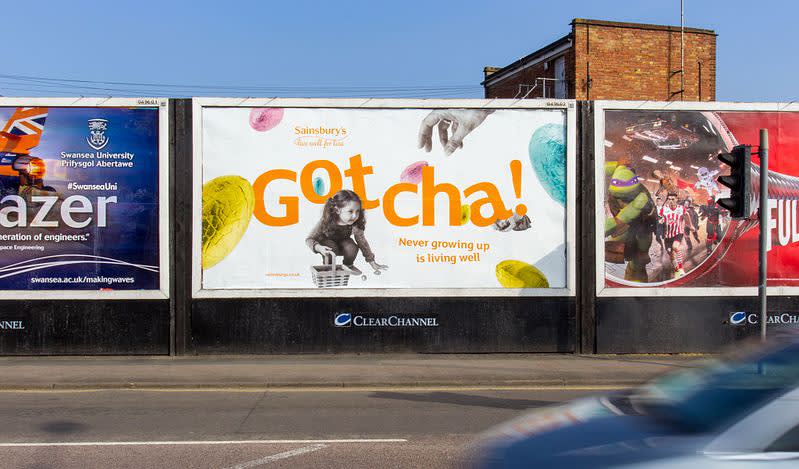You might assume that you need a massive budget for a successful billboard advertising campaign, but that’s not the case. The effectiveness of billboard advertising depends more on strategy and execution than on how much you spend.
However, understanding the average price of billboard advertising is essential when planning your OOH advertising campaign. This guide covers billboard advertising price lists, factors influencing billboard costs, and tips to maximize your return on investment in both traditional and digital Out of Home advertising.
Which factors influence the cost of billboard advertising?
While it can be true that billboard size plays a part in the cost of billboard advertising, there are many other factors that influence the price. Where you want to display your campaign, how long it runs for and whether you use static or digital billboards all come into play.
Let’s take a closer look at these factors.

Location
It doesn’t matter how big a billboard is – if it’s in the middle of nowhere and nobody’s going to see it, it’s essentially worthless. This is why location is probably the biggest factor when pricing up a billboard slot. City centres will almost always be more expensive than suburbs, as advertisements here are more likely to be seen by vast amounts of people.
Similarly, arterial routes that are travelled by thousands of commuters every day are hot property for Out of Home advertisers. Drivers often find themselves stuck in traffic on these routes, with plenty of time to observe your advert while they wait.
The visibility of a billboard therefore also plays a part. A city-centre billboard that’s positioned on the side of a building and only visible from one direction will often be cheaper than another billboard in the same area that has a clear line of sight from multiple angles.

Size
The most common sizes of billboards are 48-sheet (3m x 6m) and 96-sheet (3m x 12m) displays. Usually, the bigger the advertisement, the higher the cost. This is partly because of the extra production costs involved, but also because size is hugely tied to location.
For example, a billboard in a commercial district might be competing for attention against other elements of the environment. In this instance, a bigger billboard might help the advertisement to stand out, ensuring more impressions and a greater ROI for the advertiser.

Type
For a long time, static billboards were the only type of billboard available. But these days, brands have the choice of digital or custom billboards, too. Static billboards are often (but not always) the cheapest of the three, thanks to the simplicity of their production and maintenance.
Digital billboards usually have slightly higher maintenance and running costs, despite having the ability to be controlled remotely. They remain popular because of the many advantages they offer, including programmatic buying options and real-time updates to campaigns.
Custom billboards can also be more expensive, due to the building and design costs associated with features like 3D structures and bespoke lighting. However, the unique nature of each campaign means that the price of custom billboard advertising has the potential to vary the most.

Display period
The display period of a campaign also influences the price, with longer run times costing more, as you would reasonably expect. Likewise, running a campaign during a popular time of year might mean a rise in costs due to an increase in demand.
Programmatic billboard advertising can negate some of these costs by allowing advertisers to pick and choose the ideal times to show their creatives. If you only want to advertise to morning commuters, then you can elect to only display your creative between 6 and 9 am. Not having to pay for a continuous two-week run means that budget isn’t wasted on the wrong audience and can instead be diverted to where it is most effective.
How much does billboard advertising cost?
As billboard advertising rates are completely campaign dependent, you won’t find an accurate price list online. However, we understand that if you’re trying to grasp whether billboard advertising is affordable for your brand, a general idea of costs is useful.
For a standard static billboard, the average price across the UK industry is in the region of £200–£1,000 plus for a two-week display. The price can vary by such a large amount because of the many factors mentioned above – a billboard in a less densely populated area might cost £200 while the same billboard in central London could cost over £1,000, for example.
Tips for reducing the cost of billboard advertising:
Plan in advance – if prices are raised to meet market demand, you can avoid paying more by getting there first.
Have an audience-first approach – ensuring that your strategy is laser-focused on your audience can improve ROI and avoid budget being wasted on vanity metrics.
Extend your campaign – multiple touchpoints greatly improve the odds of activating a customer, which translates to a higher return the longer the campaign is running (we know this isn’t strictly a cost reduction, but the effect is the same).
Spread the cost – it’s not always necessary to pay in one lump sum. If applicable, opting for an alternative method of payment where possible can help to keep your budget under control.
The bottom line is that billboard advertising is priced in accordance with the expected outcome. If it costs more at Christmas due to demand, it’s because consumers are more likely to purchase at Christmas. If prime locations cost more, it’s because they enable your brand to reach more people.
To kick off your campaign or to ask any questions regarding locations, pricing and availability, speak to our local team today.
Start your billboard campaign today
Interested in learning more about billboard advertising? Fill in our form and one of our team will be in contact shortly to answer your questions and get started on your next campaign.




